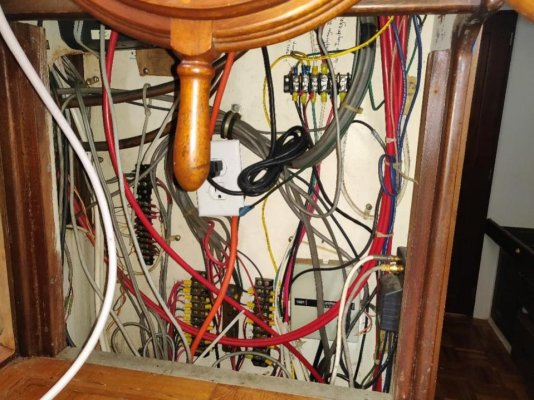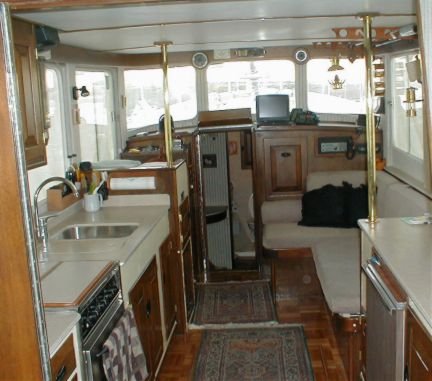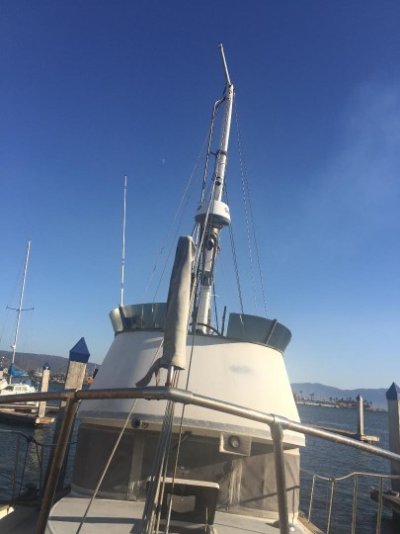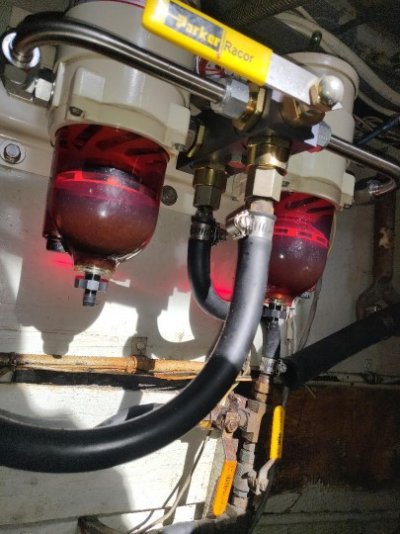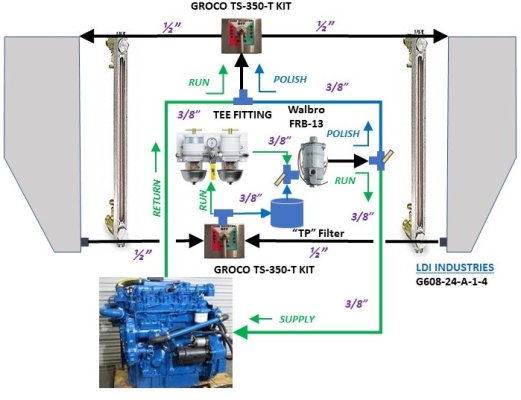mvweebles
Guru
- Joined
- Mar 21, 2019
- Messages
- 7,218
- Location
- United States
- Vessel Name
- Weebles
- Vessel Make
- 1970 Willard 36 Trawler
PROLOGUE Introduction: A really bad but exciting idea.
Cheryll and I have owned our 1970 Willard 36 (Hull #40) since we purchased her in San Francisco in 1998. We are both 60-ish, and it's time to head off cruising, a plan we had originally hatched in 2004 but set aside for career opportunities. Currency of life has changed for us - we can no longer ignore the fact that there is more highway in the rear view mirror than ahead of us, and time is more valuable than money. We have no children, so perspective on posterity looks different for us.
Contrary to popular opinion on sites such as this, buying and owning a boat is not the worst financial decision possible. Restoring one is. I can only compare the decision to restore Weebles as the same motivation a pet owner has when their beloved needs an expensive surgery. Sure, a new AKC-bred pooch could be had for a few hundred bucks, but would it really be dear old Fido?
15-years ago, I set aside a pretty decent delivery-skipper career and returned to corporate America as a management consultant. We both traveled a lot for work and decided California wanted too much of our incomes, so we moved to sunny St Pete in Florida's no income tax jurisdiction. Plan was to use Weebles as a get-away, a pied-a-mar as it were. We got out there a lot, but still, she slowly declined over the years. The plan was to bring her to Ensenada MX (just south of San Diego) to get repainted, then ship her to Florida. By the time it became reality, she needed more than paint. A very abbreviated list of necessary repairs:
From there, the list really ballooned into desirable but not necessary modifications based on how we planed to use the boat in Florida/Bahamas, and perhaps the Great Loop. This meant losing the mast and getting more sun-protection. So decided to add a hard-top and extend the boat-deck all the way back to cover the fantail (more on these later).
The do-it part of the journey really started 1-1/2 years ago, in summer of 2018 when we made the decision to restore Weebles instead of selling her and buying something else, likely a Willard 40 which has a larger engine room and a second stateroom. The final decision came down to several factors: First, Weebles is the boat we have. Second, given her state of disrepair, she would have been very difficult to sell. Third, we own a condo in Florida with a deeded slip - a 36-footer is about the largest we could possibly squeeze-in. Fourth, we just like the boat - we are nostalgic at heart and believe the classic lines of a W36 withstand the test of time. Finally, a displacement, full-keel trawler makes a really good cruiser in Florida because of no-wake zones along the ICW and there is so much skinny water here.
I'll make no apologies for meandering a bit as this thread develops, Each decision really has three steps: plan, design, build. There is often a back-story on the first two steps so some may want to just skip to the build part, or perhaps second-guess the design part. My role-model for this type of writing is Ken Williams of Sans Souci - I find his writing candid and unabashed about his choices. What I really respect about Ken's blog is he divides-up things between cruising and the actual techincal/mechanical stuff that would appeal to boat geeks/nerds. Plus, he's a great writer who keeps things light in a story-telling cadence. I'll do my best to give fair notice, but I anticipate much of this TF thread to be about decisions and design, not the actual work.
Finally, I know putting this out on TF may put a bullseye on my back from time to time. Some of my decisions may seem insane, and a few I regret already. That's fine - pundits are welcome as those conversations are helpful to others, especially folks who are relatively new to trawler-cruising.
Pictures below are


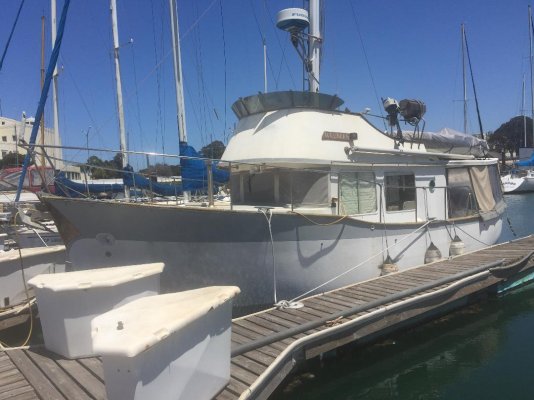
Cheryll and I have owned our 1970 Willard 36 (Hull #40) since we purchased her in San Francisco in 1998. We are both 60-ish, and it's time to head off cruising, a plan we had originally hatched in 2004 but set aside for career opportunities. Currency of life has changed for us - we can no longer ignore the fact that there is more highway in the rear view mirror than ahead of us, and time is more valuable than money. We have no children, so perspective on posterity looks different for us.
Contrary to popular opinion on sites such as this, buying and owning a boat is not the worst financial decision possible. Restoring one is. I can only compare the decision to restore Weebles as the same motivation a pet owner has when their beloved needs an expensive surgery. Sure, a new AKC-bred pooch could be had for a few hundred bucks, but would it really be dear old Fido?
15-years ago, I set aside a pretty decent delivery-skipper career and returned to corporate America as a management consultant. We both traveled a lot for work and decided California wanted too much of our incomes, so we moved to sunny St Pete in Florida's no income tax jurisdiction. Plan was to use Weebles as a get-away, a pied-a-mar as it were. We got out there a lot, but still, she slowly declined over the years. The plan was to bring her to Ensenada MX (just south of San Diego) to get repainted, then ship her to Florida. By the time it became reality, she needed more than paint. A very abbreviated list of necessary repairs:
Hull paint
Topsides paint
Caprail repair
Weeping stbd fuel tank (termite damage)
Service stabilizers
Topsides paint
Caprail repair
Weeping stbd fuel tank (termite damage)
Service stabilizers
From there, the list really ballooned into desirable but not necessary modifications based on how we planed to use the boat in Florida/Bahamas, and perhaps the Great Loop. This meant losing the mast and getting more sun-protection. So decided to add a hard-top and extend the boat-deck all the way back to cover the fantail (more on these later).
The do-it part of the journey really started 1-1/2 years ago, in summer of 2018 when we made the decision to restore Weebles instead of selling her and buying something else, likely a Willard 40 which has a larger engine room and a second stateroom. The final decision came down to several factors: First, Weebles is the boat we have. Second, given her state of disrepair, she would have been very difficult to sell. Third, we own a condo in Florida with a deeded slip - a 36-footer is about the largest we could possibly squeeze-in. Fourth, we just like the boat - we are nostalgic at heart and believe the classic lines of a W36 withstand the test of time. Finally, a displacement, full-keel trawler makes a really good cruiser in Florida because of no-wake zones along the ICW and there is so much skinny water here.
I'll make no apologies for meandering a bit as this thread develops, Each decision really has three steps: plan, design, build. There is often a back-story on the first two steps so some may want to just skip to the build part, or perhaps second-guess the design part. My role-model for this type of writing is Ken Williams of Sans Souci - I find his writing candid and unabashed about his choices. What I really respect about Ken's blog is he divides-up things between cruising and the actual techincal/mechanical stuff that would appeal to boat geeks/nerds. Plus, he's a great writer who keeps things light in a story-telling cadence. I'll do my best to give fair notice, but I anticipate much of this TF thread to be about decisions and design, not the actual work.
Finally, I know putting this out on TF may put a bullseye on my back from time to time. Some of my decisions may seem insane, and a few I regret already. That's fine - pundits are welcome as those conversations are helpful to others, especially folks who are relatively new to trawler-cruising.
Pictures below are
1970 launch in Newport Beach (Willard was located a few miles inland, in Costa Mesa)
1999 Weebles in good condition anchored in Clipper Cove, near Treasure Island Naval Base in San Francisco; and
2018 Weebles shortly before departing San Francisco for Ensenada and in pretty poor conditions (more on this later).
1999 Weebles in good condition anchored in Clipper Cove, near Treasure Island Naval Base in San Francisco; and
2018 Weebles shortly before departing San Francisco for Ensenada and in pretty poor conditions (more on this later).



Last edited:



